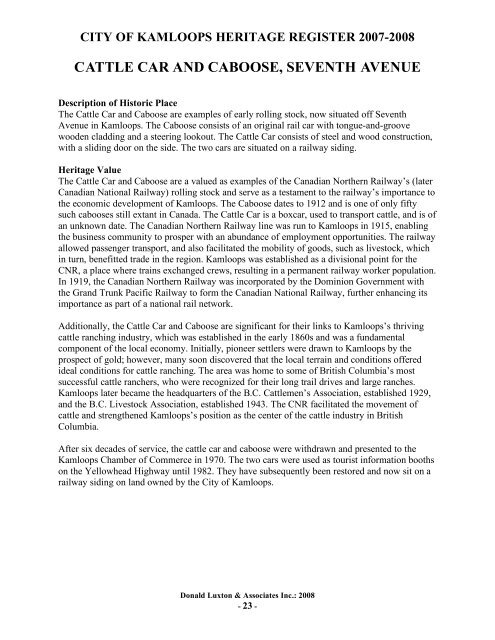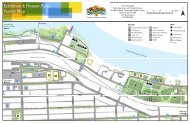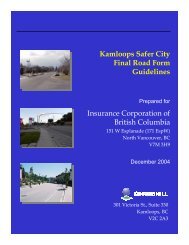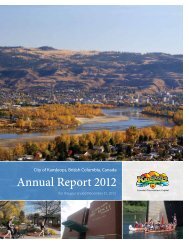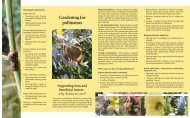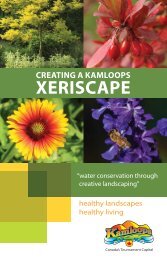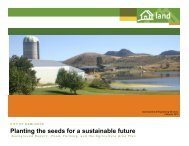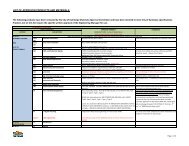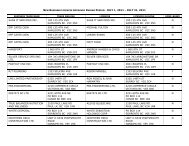Kamloops Heritage Register - City of Kamloops
Kamloops Heritage Register - City of Kamloops
Kamloops Heritage Register - City of Kamloops
Create successful ePaper yourself
Turn your PDF publications into a flip-book with our unique Google optimized e-Paper software.
CITY OF KAMLOOPS HERITAGE REGISTER 2007-2008<br />
CATTLE CAR AND CABOOSE, SEVENTH AVENUE<br />
Description <strong>of</strong> Historic Place<br />
The Cattle Car and Caboose are examples <strong>of</strong> early rolling stock, now situated <strong>of</strong>f Seventh<br />
Avenue in <strong>Kamloops</strong>. The Caboose consists <strong>of</strong> an original rail car with tongue-and-groove<br />
wooden cladding and a steering lookout. The Cattle Car consists <strong>of</strong> steel and wood construction,<br />
with a sliding door on the side. The two cars are situated on a railway siding.<br />
<strong>Heritage</strong> Value<br />
The Cattle Car and Caboose are a valued as examples <strong>of</strong> the Canadian Northern Railway’s (later<br />
Canadian National Railway) rolling stock and serve as a testament to the railway’s importance to<br />
the economic development <strong>of</strong> <strong>Kamloops</strong>. The Caboose dates to 1912 and is one <strong>of</strong> only fifty<br />
such cabooses still extant in Canada. The Cattle Car is a boxcar, used to transport cattle, and is <strong>of</strong><br />
an unknown date. The Canadian Northern Railway line was run to <strong>Kamloops</strong> in 1915, enabling<br />
the business community to prosper with an abundance <strong>of</strong> employment opportunities. The railway<br />
allowed passenger transport, and also facilitated the mobility <strong>of</strong> goods, such as livestock, which<br />
in turn, benefitted trade in the region. <strong>Kamloops</strong> was established as a divisional point for the<br />
CNR, a place where trains exchanged crews, resulting in a permanent railway worker population.<br />
In 1919, the Canadian Northern Railway was incorporated by the Dominion Government with<br />
the Grand Trunk Pacific Railway to form the Canadian National Railway, further enhancing its<br />
importance as part <strong>of</strong> a national rail network.<br />
Additionally, the Cattle Car and Caboose are significant for their links to <strong>Kamloops</strong>’s thriving<br />
cattle ranching industry, which was established in the early 1860s and was a fundamental<br />
component <strong>of</strong> the local economy. Initially, pioneer settlers were drawn to <strong>Kamloops</strong> by the<br />
prospect <strong>of</strong> gold; however, many soon discovered that the local terrain and conditions <strong>of</strong>fered<br />
ideal conditions for cattle ranching. The area was home to some <strong>of</strong> British Columbia’s most<br />
successful cattle ranchers, who were recognized for their long trail drives and large ranches.<br />
<strong>Kamloops</strong> later became the headquarters <strong>of</strong> the B.C. Cattlemen’s Association, established 1929,<br />
and the B.C. Livestock Association, established 1943. The CNR facilitated the movement <strong>of</strong><br />
cattle and strengthened <strong>Kamloops</strong>’s position as the center <strong>of</strong> the cattle industry in British<br />
Columbia.<br />
After six decades <strong>of</strong> service, the cattle car and caboose were withdrawn and presented to the<br />
<strong>Kamloops</strong> Chamber <strong>of</strong> Commerce in 1970. The two cars were used as tourist information booths<br />
on the Yellowhead Highway until 1982. They have subsequently been restored and now sit on a<br />
railway siding on land owned by the <strong>City</strong> <strong>of</strong> <strong>Kamloops</strong>.<br />
Donald Luxton & Associates Inc.: 2008<br />
- 23 -


